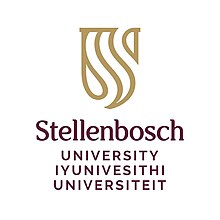This article may have too many links. (November 2024) |
Universiteit Stellenbosch or Stellenbosch Universiteit | |
 | |
| Motto | Latin: Pectora roborant cultus recti |
|---|---|
Motto in English | "A sound education strengthens the spirit" |
| Type | Public |
| Established | 2 April 1918 |
| Endowment | ZAR 5.04 Billion[1] |
| Chancellor | Edwin Cameron |
| Vice-Chancellor | Wim de Villiers |
Academic staff | 1028[2] |
Administrative staff | 2183[2] |
| Undergraduates | 25,042[3] |
| Postgraduates | 10,051[3] |
| Location | , , South Africa (SA) 33°55′58″S 18°51′51″E / 33.93278°S 18.86417°E |
| Campus | 2 suburban, 2 urban and 1 rural |
| Colours | Maroon |
| Nickname | Maties |
| Affiliations | |
| Mascot | Pokkel[4] |
| Website | www |
Stellenbosch University (SU) (Afrikaans: Universiteit Stellenbosch, Xhosa: iYunivesithi yaseStellenbosch) is a public research university situated in Stellenbosch, a town in the Western Cape province of South Africa. Stellenbosch is the oldest university in South Africa and the oldest extant university in Sub-Saharan Africa, which received full university status in 1918.[5] Stellenbosch University designed and manufactured Africa's first microsatellite, SUNSAT, launched in 1999.[6]
Stellenbosch is organised in 139 departments across 10 faculties offering bachelor's (NQF 7) to doctoral degrees (NQF 10) in the English and Afrikaans language.[7][8] Across five campuses in the Western Cape, the university is home to 32,000 students.
The students of Stellenbosch University are nicknamed "Maties". The term probably arises from the Afrikaans word "tamatie" (meaning tomato, and referring to the maroon sports uniforms and blazer colour). An alternative theory is that the term comes from the Afrikaans colloquialism maat (meaning "buddy" or "mate"), originally used diminutively ("maatjie") by the students of the University of Cape Town's precursor, the South African College.[9]
- ^ "These are the richest universities in South Africa". BusinessTech.
- ^ a b "Statistical Profile". www.sun.ac.za. Archived from the original on 9 April 2018. Retrieved 28 March 2018.
- ^ a b "Error". www.sun.ac.za. Archived from the original on 29 March 2018. Retrieved 28 March 2018.
- ^ "Meet Pokkel the Maties mascot" Archived 13 June 2011 at the Wayback Machine, Matie News, 18 February 2009
- ^ "Space in South Africa | Space Lab". www.spacelab.uct.ac.za. Retrieved 24 May 2022.
- ^ "SUNSAT - eoPortal Directory - Satellite Missions". directory.eoportal.org. Archived from the original on 10 May 2017. Retrieved 27 February 2017.
- ^ "CHE | Council on Higher Education | Regulatory body for Higher Education in South Africa | Education | Innovation | University | South Africa". che.ac.za. Archived from the original on 24 May 2020. Retrieved 25 May 2020.
- ^ "Language at Stellenbosch University". www.sun.ac.za. Retrieved 18 April 2024.
- ^ "Stellenbosch University – SEC CERT". Archived from the original on 23 October 2020. Retrieved 25 May 2020.